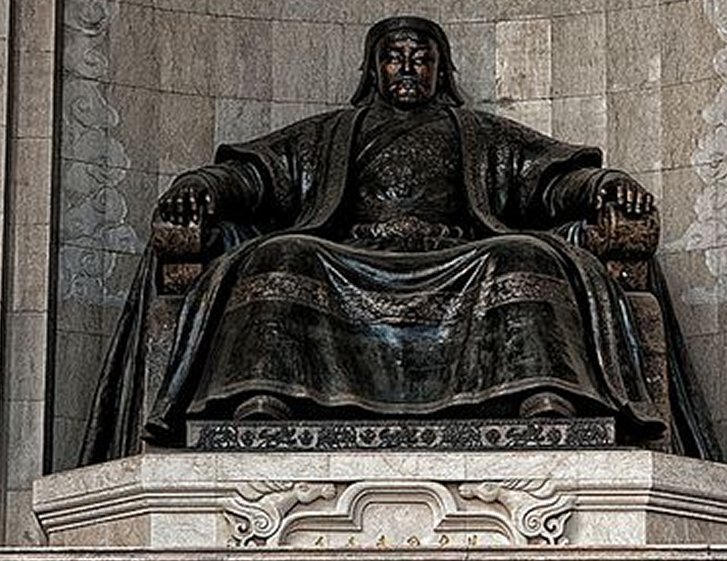Genghis Khan Has 16 Million Relatives – You Could Be One Of Them
Ellen Lloyd - AncientPages.com - Legendary Mongol leader Genghis Khan (1162-1227) is today famous for establishing the largest empire in history. He was a ruthless killer, but also a brilliant military innovator who practiced the ‘surrender or die’ policy.
Genghis Khan massacred millions of Asian and Eastern European people. However, he also practiced religious and racial tolerance, and his Mongolian Empire valued the leadership of women.
Genghis Khan married at age 16, but had many wives during his lifetime and naturally plenty of children.
He and his sons vanquished peoples from the Adriatic to the Pacific, reaching modern Austria, Finland, Croatia, Hungary, Poland, Vietnam, Burma, Japan and Indonesia. At their peak, the Mongols controlled between 11 and 12 million contiguous square miles, an area about the size of Africa.
Modern developments in DNA testing have revealed a vast number of people may, in fact, be directly related to Mongolian warrior king Genghis Khan.
A 2003 groundbreaking historical genetics study revealed that close to 8 % of men living in the former Mongol Empire carry identical Y-chromosomes. That 8% is 0.5 percent of the male worldwide population, which translates to a staggering 16 million descendants alive today.
Scientists have traced this lineage back to around 1,000 years ago, and the very special set of circumstances required for such a vast spread of DNA point to one man – a certain Genghis Khan.
“We have identified a Y-chromosomal lineage with several unusual features. It was found in 16 populations throughout a large region of Asia, stretching from the Pacific to the Caspian Sea, and was present at high frequency: ∼8% of the men in this region carry it, and it thus makes up ∼0.5% of the world total.
The pattern of variation within the lineage suggested that it originated in Mongolia ∼1,000 years ago. Such a rapid spread cannot have occurred by chance; it must have been a result of selection.
The lineage is carried by likely male-line descendants of Genghis Khan, and we, therefore, propose that it has spread by a novel form of social selection resulting from their behavior,” researchers of the American Society of Human Genetics state.
We mustn’t forget that Genghis Khan and his sons were well-known for their brutality and rapes. The number of offspring his own sons boasted was staggering. His oldest son had 40 sons and numerous daughters. One of his grandsons had 22 legitimate sons. If we add to this, his other sons and their children, we get a good idea of how it’s really possible so many people are descendants of Genghis Khan.
Although this theory is impossible to ascertain without a sample of Khan’s own DNA and we have no access to his body, it does seem likely that these identical chromosomes are linked in some way to Genghis Khan.
Genghis Khan died on August 18, 1227, during the siege of Ningxia. The cause of his death remains unknown and has been attributed to being slain in battle, illness, falling from a horse.
His final resting place remains unknown. There are suspicions the tomb of Genghis Khan is hidden in the Khentii Mountains. It is allegedly protected because people fear it’s cursed, but these are only rumors and solid evidence is missing.
Written by Ellen Lloyd – AncientPages.com
Copyright © AncientPages.com All rights reserved. This material may not be published, broadcast, rewritten or redistributed in whole or part without the express written permission of AncientPages.com
Expand for referencesMore From Ancient Pages
-
 Ancient Egyptian Blue Used To Create New Nanomaterial 100,000 Times Thinner Than A Human Hair
Ancient Technology | Mar 24, 2020
Ancient Egyptian Blue Used To Create New Nanomaterial 100,000 Times Thinner Than A Human Hair
Ancient Technology | Mar 24, 2020 -
 Roman-Era Residence Unearthed In Ancient Capital Of Memphis, Egypt
Archaeology | Sep 27, 2018
Roman-Era Residence Unearthed In Ancient Capital Of Memphis, Egypt
Archaeology | Sep 27, 2018 -
 Ancient DNA Pushes Herring Trade Back To The Viking Age
Archaeology | Oct 26, 2022
Ancient DNA Pushes Herring Trade Back To The Viking Age
Archaeology | Oct 26, 2022 -
 DNA Identifies Historical Remains Of George Washington’s Relatives
DNA | Mar 29, 2024
DNA Identifies Historical Remains Of George Washington’s Relatives
DNA | Mar 29, 2024 -
 Nomadic People’s 1,500-Year-Old Imperial Worship Unearthed In Hohhot, Inner Mongolia
Archaeology | Nov 18, 2020
Nomadic People’s 1,500-Year-Old Imperial Worship Unearthed In Hohhot, Inner Mongolia
Archaeology | Nov 18, 2020 -
 Ruins Of Biblical City Of Corinth Discovered Underwater – Giant Monuments and Remains Of Lighthouse Still Well-Preserved
Archaeology | Dec 19, 2017
Ruins Of Biblical City Of Corinth Discovered Underwater – Giant Monuments and Remains Of Lighthouse Still Well-Preserved
Archaeology | Dec 19, 2017 -
 Mythical Beautiful Adarna Bird And Its Harmful Magical Power In Mythology Of Philippines
Myths & Legends | Jan 25, 2017
Mythical Beautiful Adarna Bird And Its Harmful Magical Power In Mythology Of Philippines
Myths & Legends | Jan 25, 2017 -
 Evidence Of The Moon-Eyed People – Strange Runic Tablet And A Curious Discovery In North Dakota – Part 1
Ancient Mysteries | Dec 26, 2019
Evidence Of The Moon-Eyed People – Strange Runic Tablet And A Curious Discovery In North Dakota – Part 1
Ancient Mysteries | Dec 26, 2019 -
 Neanderthal Hunting Camp Discovered In The Center Of The Iberian Peninsula
Archaeology | Aug 30, 2021
Neanderthal Hunting Camp Discovered In The Center Of The Iberian Peninsula
Archaeology | Aug 30, 2021 -
 Tullus Hostilius: Warrior King Of Rome, Who Succeeded Numa Pompilius And Feared Prophecies
Featured Stories | Mar 6, 2019
Tullus Hostilius: Warrior King Of Rome, Who Succeeded Numa Pompilius And Feared Prophecies
Featured Stories | Mar 6, 2019 -
 New Discoveries Regarding Gladiatorial Games In Roman City Of Carnuntum
Archaeology | Apr 7, 2017
New Discoveries Regarding Gladiatorial Games In Roman City Of Carnuntum
Archaeology | Apr 7, 2017 -
 Escape Tunnel From Crusader Citadel In Tiberias To Sea Of Galilee – Discovered
Archaeology | Jun 15, 2017
Escape Tunnel From Crusader Citadel In Tiberias To Sea Of Galilee – Discovered
Archaeology | Jun 15, 2017 -
 Mysterious Sumerian Star Tablet And Strange Divine Omens – Communication With The Gods – Part 2
Ancient Mysteries | Feb 18, 2021
Mysterious Sumerian Star Tablet And Strange Divine Omens – Communication With The Gods – Part 2
Ancient Mysteries | Feb 18, 2021 -
 Three Punic Wars Between Rome And Carthage Lasted Almost A Hundred Years
Featured Stories | Apr 29, 2019
Three Punic Wars Between Rome And Carthage Lasted Almost A Hundred Years
Featured Stories | Apr 29, 2019 -
 Map May Confirm The Legend Of The Mysterious Lost Sunken Welsh Kingdom Of Cantre’r Gwaelod In The Black Book Of Carmarthen
Archaeology | Aug 21, 2022
Map May Confirm The Legend Of The Mysterious Lost Sunken Welsh Kingdom Of Cantre’r Gwaelod In The Black Book Of Carmarthen
Archaeology | Aug 21, 2022 -
 Ancestor Of Italian Pizza Depicted On Fresco In Pompeii
Archaeology | Jun 28, 2023
Ancestor Of Italian Pizza Depicted On Fresco In Pompeii
Archaeology | Jun 28, 2023 -
 Bacho Kiro Cave: Genomes Of The Earliest Europeans – Sequenced
Archaeology | Apr 8, 2021
Bacho Kiro Cave: Genomes Of The Earliest Europeans – Sequenced
Archaeology | Apr 8, 2021 -
 Why Did First Printed Books Scare Ancient Scholars In Europe?
Ancient History Facts | Sep 18, 2021
Why Did First Printed Books Scare Ancient Scholars In Europe?
Ancient History Facts | Sep 18, 2021 -
 On This Day In History: Terrorist Attacks On World Trade Center And Pentagon – On Sep 11, 2001
News | Sep 11, 2016
On This Day In History: Terrorist Attacks On World Trade Center And Pentagon – On Sep 11, 2001
News | Sep 11, 2016 -
 Coronavirus: Advice From The Middle Ages For How To Cope With Self-Isolation
Featured Stories | Mar 29, 2020
Coronavirus: Advice From The Middle Ages For How To Cope With Self-Isolation
Featured Stories | Mar 29, 2020


